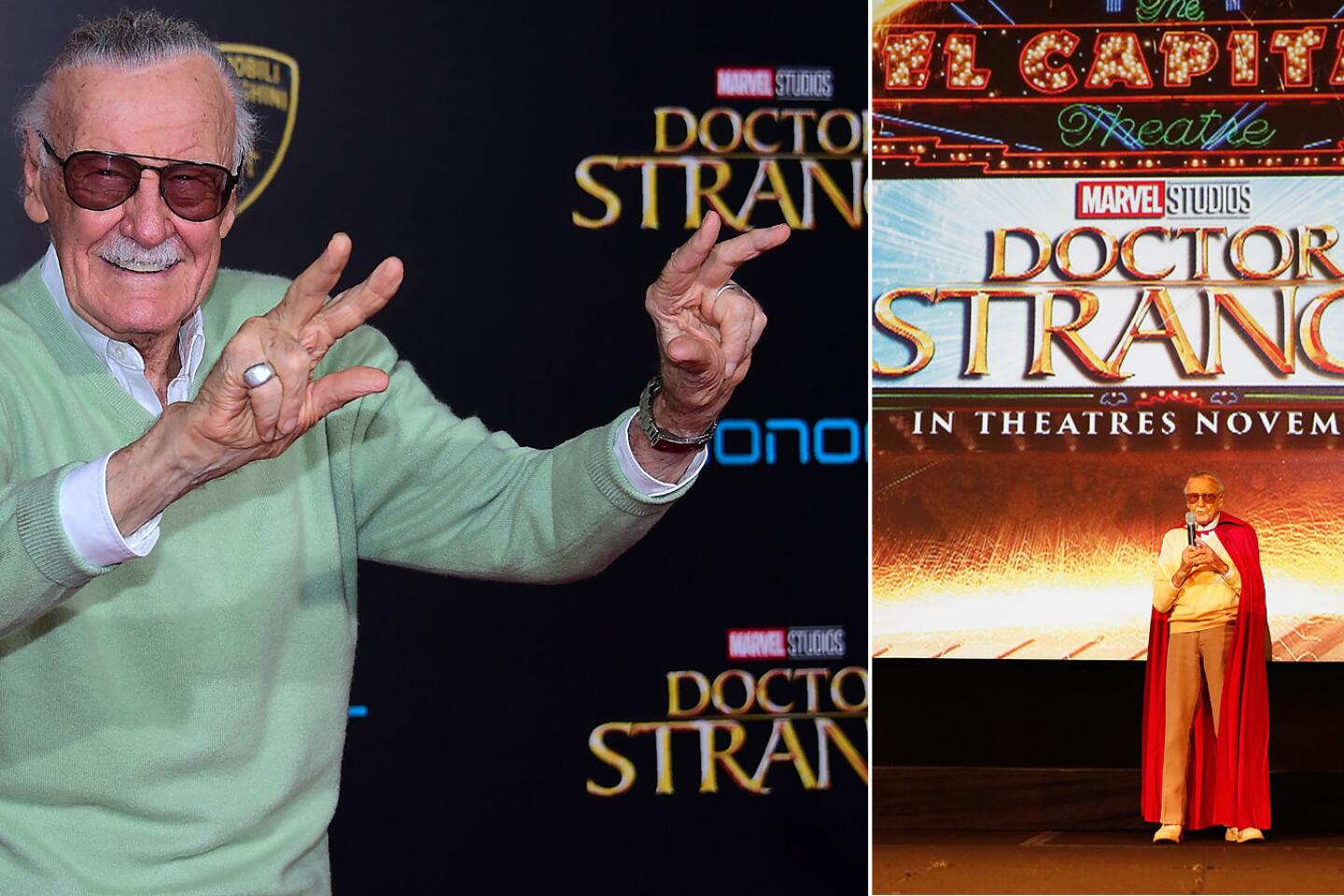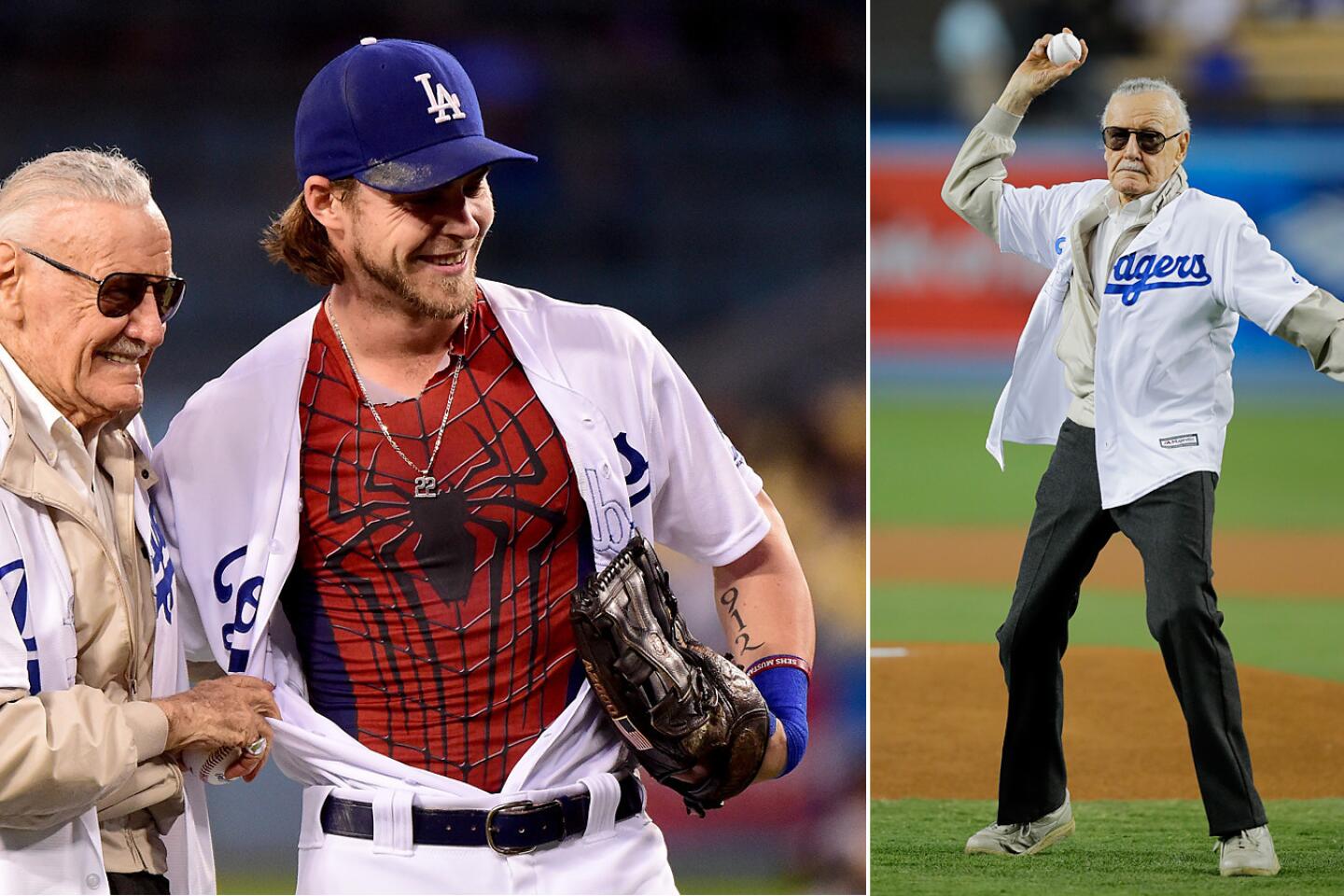Comic-book legend Stan Lee, co-creator of Spider-Man and Marvel heroes, dies at 95

A look back at what fans and fellow comic book writers had to say about what Stan Lee means to them.
- Share via
When he got his start in the 1940s, Stan Lee was embarrassed by his profession.
“I would meet someone at a party, and they would ask what I did and I would say, ‘I’m a writer,’ then start to walk away,” the man who helped create Spider-Man and other famed superheroes recalled years later.
Pressed for more details, he would say he wrote for magazines. And if the questions kept coming?
“Finally I would say, ‘comic books,’” Lee said. “And they would walk away from me.”
A half-century later, the writer who in the 1960s spearheaded Marvel Comics’ transformation into a powerhouse brand was considered a superhero in his own right. He was mobbed by fans at conventions and became the toast of Hollywood, with blockbuster films based on his characters racking up billions at the box office.
Lee died Monday at Cedars-Sinai Medical Center in Los Angeles, according to an attorney for Lee’s daughter, J.C. Lee. He was 95. His cause of death was not immediately known.
“J.C. Lee and all of Stan Lee’s friends and colleagues want to thank all of his fans and well wishers for their kind words and condolences,” the Lee family said in a statement.
“Stan was an icon in his field. His fans loved him and his desire to interact with them. He loved his fans and treated them with the same respect and love they gave him,” the statement continued.
“He worked tirelessly his whole life creating great characters for the world to enjoy. He wanted to inspire our imagination and for us to all use it to make the world a better place. His legacy will live on forever. Excelsior.”
Lee’s official Twitter account verified the news too, with a tweet that also quoted his catchphrase: “1922 - 2018 Excelsior!”
In recent years, Lee was credited as associate producer on many of the blockbuster movies — including multiple sequels — starring Marvel characters Iron Man, X-Men and Captain America, in addition to Spider-Man.
Marvel Comics and the Walt Disney Company honored Lee in a statement posted online Monday.
“Stan Lee was as extraordinary as the characters he created,” said Bob Iger, chairman and CEO of the Walt Disney Company. “A super hero in his own right to Marvel fans around the world, Stan had the power to inspire, to entertain, and to connect. The scale of his imagination was only exceeded by the size of his heart.”
“No one has had more of an impact on my career and everything we do at Marvel Studios than Stan Lee,” tweeted Kevin Feige, the president of Marvel Studios. “Stan leaves an extraordinary legacy that will outlive us all.”
Lee’s legacy was celebrated far and wide on social media Monday, and the man once embarrassed by his work was showered with adulation and praised as a cultural transformer.
As the guiding force behind the spectacular rise of Marvel Comics in the 1960s, Lee — and his artistic collaborators — devised characters that broke the mold of conventional comic-book superheroes: No longer were they one-dimensional costumed crusaders who were all good, struggling against villains who were all bad.
Marvel’s superheroes, which Lee developed with Marvel artists such as Jack Kirby and Steve Ditko, battled not only complex villains but also their own personal demons in stories that have been praised for their “wit and subtleties” — ingredients that greatly expanded the appeal and readership of comic books.
Lee and Kirby launched the new era of humanized comic-book superheroes in 1961 with the debut of the Fantastic Four: Mr. Fantastic, the Invisible Girl, the Human Torch and the Thing.
The crime-fighting quartet — scientist Reed Richards; his fiancée, Sue Storm; her teenage brother, Johnny; and test pilot Ben Grimm — obtained their superpowers after their experimental rocket ship passed through cosmic rays that altered their atomic structures.
And although they gained superpowers, they also retained their all-too-human personalities.
Although Richards amazingly could now stretch and bend his body into any shape as Mr. Fantastic, for example, he could be as boorishly long-winded and pompous as ever. And Grimm could caustically reprimand him by saying, “You don’t have to make a speech, big shot!”
Marvel’s new series was an immediate hit.
With its success, the Marvel universe expanded to include the Hulk, the X-Men, Thor, the Silver Surfer, Doctor Strange, Daredevil, Iron Man, the Avengers and many other characters.
But the character that Marvel had the most success with was Spider-Man, which Lee and Ditko introduced in August 1962.
Spider-Man’s alter ego, Peter Parker, was a bookish and alienated teenager who gained his superpowers after being bitten by a radioactive spider.
Although the web-slinging crime fighter clashed with various villains, he was still the same geeky Parker: a bookworm who is bullied by football players, ignored by girls and lives with his motherly aunt, who reminds him to wear his galoshes in the rain.
“You ask the audience to suspend disbelief and accept that some idiot can climb on walls,” Lee said in a 1992 Washington Post interview, “but once that’s accepted, you ask: What would life be like in the real world if there were such a character? Would he still have to worry about dandruff, about acne, about getting girlfriends, about keeping a job?”
Gary Groth, co-founder of comics and graphic novels publisher Fantagraphics Books, told The Times in 2002 that Lee’s reputation rested on approximately nine years of work, from 1961 to 1970, and mostly in collaboration with Kirby and Ditko.
“What he did in those nine years and what he helped Kirby and Ditko achieve — the kind of synergy they must have had working off each other — was a high-water mark in the history of the comic book,” Groth said.
Tall, lean and fit, with a trim mustache and green-gray eyes hidden by his trademark prescription sunglasses, Lee was much sought after by the media. He did interviews, appeared on TV talk shows, lectured at universities and, in 1972, even presented an “Evening With Stan Lee” at Carnegie Hall.
“Stan, because of his personality and ability to talk in front of people, became the spokesman for all the comic books,” Bill Liebowitz, long the owner of Golden Apple Comics in Los Angeles, said in a Times interview before his own death in 2004. “He’s the guy who got on Johnny Carson, the guy who always got interviewed, because he had a quick wit and easy way about him.”
He was born Stanley Martin Lieber to Romanian immigrant parents in New York City on Dec. 28, 1922. While in high school, his flair for writing landed him a part-time job turning out advance obituaries of famous people for the Associated Press, a job he quit after growing “tired of writing about living people in the past tense.”
After graduating in 1939, Lee landed an $8-a-week job as an editorial assistant at a small publishing company in Manhattan owned by Martin Goodman, the husband of Lee’s cousin Jean.
One of the earliest publishers of pulp magazines, Goodman published comic books under the name Timely Comics.
From sweeping floors and proofreading, Lee quickly worked his way up to assistant to Kirby, then the art director, and Joe Simon, the editor.
His first written piece for Timely (later renamed Atlas Comics before becoming Marvel Comics in the early ’60s) appeared in Captain America No. 3 in May 1941: “Captain America Foils The Traitor’s Revenge!”
By August, he was a published comic book scriptwriter. But instead of using his real name, he used the pen name Stan Lee. With ambitions of becoming a novelist, he later said, he didn’t want to have his real name associated with what he considered “these silly little books.”
When both Kirby and Simon left Timely Comics in 1941, Lee, not yet 19, was asked to fill in as editor and art director. By then, he was writing many of the company’s comic book scripts, finding that his longtime love of reading and going to the movies helped him come up with simple plot ideas.
After Pearl Harbor, Lee enlisted in the Army but remained stateside during World War II, writing instructional manuals and scripts for Signal Corps training films. In his spare time, he freelanced comic book scripts for Timely. After the war, he returned to his old job.
In 1961, he was about to follow through on one of his periodic threats to quit the comic-book business when publisher Goodman asked him to come up with a team of superheroes to compete with DC Comics’ (then called National Periodical Publications) new Justice League of America series featuring its stable of superheroes that included Superman, Batman and Wonder Woman.
He had planned on telling Goodman he was going to leave the company, he recalled, but that night his wife talked him out of it.
As recounted in his 2002 book “Excelsior!: The Amazing Life of Stan Lee” (written with George Mair), his wife told him that it was a perfect opportunity for him to create comic book heroes the way he’d always wanted to write them: characters who speak like real people and have depth and substance to them, and he could do it in a style he’d always wanted to do that would attract older readers as well as younger ones.
On a creative roll throughout the ’60s, Lee scripted most of Marvel’s superhero comic books but began to have less hands-on involvement beginning in the ’70s. In 1972, he stepped down as editor-in-chief and became Marvel’s publisher and editorial director.
By the late ’70s, Lee was primarily writing only the Spider-Man newspaper cartoon strip, which his brother Larry drew, and spending the rest of his time supervising the transition of Marvel’s characters into other media such as “The Incredible Hulk,” the hit TV series starring Bill Bixby and Lou Ferrigno.
By the early ’80s, Lee had left New York for Los Angeles to oversee Marvel’s animation studios, which produced cartoon adaptations.
In 1998, Marvel filed for bankruptcy, voiding a $1-million-a-year contract with Lee. This set off a complex series of lawsuits, filed by Lee and in some cases filed by others against him. In 2005, Marvel and Lee reached a settlement over film royalties, the terms of which were not made public.

In the months leading up to his death, Lee was still embroiled in a series of legal battles.
In August, he was granted a three-year restraining order against former business manager and caregiver Keya Morgan, who had been accused of filing a false police report and engaging in elder abuse against the comic-book legend.
He also sued another former associate, Jerardo Olivarez, accusing him of fraudulent behavior that resulted in the loss of “a tremendous amount of money,” according to a complaint filed in April.
In July, Lee dropped his $1-billion lawsuit against Pow Entertainment, the L.A.-based media outfit he co-founded in 2001 that was sold to a Hong Kong company last year.
Lee was listed as executive producer on numerous, hugely successful films starring Marvel characters, including Spider-Man, X-Men and Iron Man and made dozens of cameo appearances in Marvel blockbusters, usually as an unsuspecting bystander offering a moment of levity. As he advanced in age, Lee began to shoot his cameos back-to-back in anticipation.
In 2015, he published “Amazing Fantastic Incredible: A Marvelous Memoir,” an illustrated memoir.
He was a major draw at fan conventions around the world, including Comic-Con in San Diego. In 2012, he entered into a partnership with producers of a Los Angeles convention that became known as Stan Lee’s Comikaze.
“The enthusiasm of the convention-goers is so exciting, it’s like nourishment,” he said in a 2014 Times interview. “When you go there, and you realize that all these people are really involved and really care about the things you’re doing, you can’t get tired.
“It’s like getting a tonic every time.”
Lee is survived by a daughter, Joan Celia (J.C.) Lee, and a brother, Larry Lieber. Joan, his wife of nearly 70 years, died in July 2017, and a second daughter died shortly after birth in 1953.
McLellan and Colker are former Times staff writers.
Times staff writer Nardine Saad contributed to this report.
UPDATES:
1:30 p.m.: This story was updated to include a statement from Lee’s family.
12:35 p.m.: This story was updated to include statements from Marvel and Disney and additional reporting on Lee’s legal battles.
This story was originally published at 11:15 a.m.
More to Read
Start your day right
Sign up for Essential California for the L.A. Times biggest news, features and recommendations in your inbox six days a week.
You may occasionally receive promotional content from the Los Angeles Times.




















